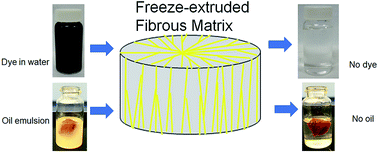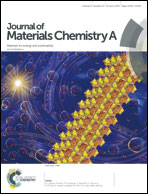Freeze-extrusion for controllable assembly of 3-dimensional ultra-fine and amorphous fibrous matrices: potential applications in sorption†
Abstract
This paper studies the formation mechanism, properties and applications of fibrous matrices via freeze-extrusion. Though some porous fibrous materials via freezing and freeze-drying have been developed, applications of these materials are limited due to the lack of comprehensive studies on their formation mechanism. We demonstrate that polymers continue their concentration, precipitation, and accumulation along the direction of the temperature gradient in gaps between ices before the formation of fibrous matrices. Fibers with branched structures in matrices from freeze-extrusion are continuous and have large amorphous areas. Alignments of fibers are controllable. The porosity of freeze-extruded fibrous matrices is as high as 99.93%. These properties endow such matrices with good mechanical properties and excellent performance in water treatment. Good mechanical properties of these matrices ensure their reusability in water treatments. Sorption capacities of these matrices for major water pollutants, such as textile dyes and organic solvents, are as high as 1200 mg g−1 and 34 000%, respectively. The sorption capacities remain almost the same even after 50 reuses.



 Please wait while we load your content...
Please wait while we load your content...
